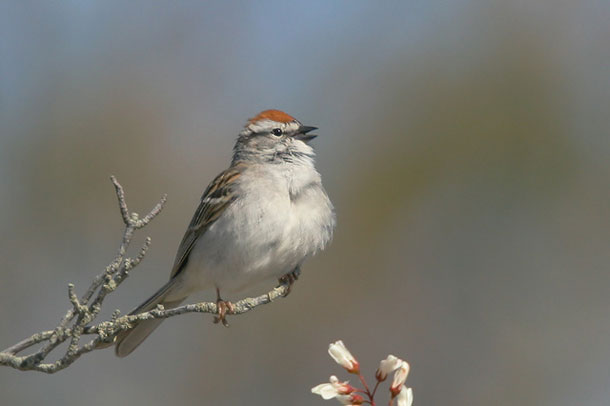BirdNote®: Chipping Sparrows: Song Learning Starts Early
Air Date: Week of October 5, 2018

The Chipping Sparrow can be easily identified by its orange-colored cap. (Photo: Mike Hamilton)
For anyone who has taken a moment to listen to birdsongs on a walk outside or has dropped a crumb on a sidewalk at lunch, the Chipping Sparrow is most likely a familiar sight. But scientists are still unlocking the secrets of this common bird. In this week’s BirdNote, Mary McCann gives us a closer look into recent research that shows how young Chipping Sparrows develop their signature songs.
Transcript
CURWOOD: Our beloved songbirds are getting ready to make their way south again for the winter. As Birdnote’s Mary McCann tells us, this is actually an important time of year for young birds to learn the songs that will help them survive and ultimately find a mate next spring.
[Chipping Sparrow song]
Few songbirds are more familiar across North America than the Chipping Sparrow.
[Chipping Sparrow song]
Petite and rufous-capped, Chipping Sparrows breed over much of the continent. They winter in the southern U.S. and Central America. Yet familiar as the birds may seem, scientists are still unlocking their secrets. Recent research shows that when baby male Chipping Sparrows beg for food, their first begging calls already show a connection with the songs they will develop.
[Chipping Sparrow begging calls]

A Chipping Sparrow in song. (Photo: Tom Grey)
Soon, the young males’ begging calls mix into what is known as “subsong,” a sort of infant babbling for young male birds. And, very quickly, subsong begins to transition to imitations of adult songs. By the time a young male Chipping Sparrow migrates south in early October, it has developed five to seven “precursor songs” – works in progress, but closer to adult songs. Next spring, when the young male returns north for its first breeding season, it will settle in near an older male. Soon it drops all but one of the precursor songs – the one most like the older male’s song – and in a few days, nearly matches its neighbor note for note.
[Chipping Sparrow song]
Then for the real test of its new song – attracting its first mate.
[Chipping Sparrow song]
I’m Mary McCann.
Chipping Sparrow begging call provided by Borror Laboratory of Bioacoustics, Department of Evolution, Ecology, and Organismal Biology, Ohio State University, Columbus, OH, all rights reserved.
Producer: John Kessler
Executive Producer: Chris Peterson
© 2012 Tune In to Nature.org October 2018 Narrator: Mary McCann
CURWOOD: For photos of the chipping sparrow migrate on over to our website L-O-E dot org.
Links
Living on Earth wants to hear from you!
Living on Earth
62 Calef Highway, Suite 212
Lee, NH 03861
Telephone: 617-287-4121
E-mail: comments@loe.org
Newsletter [Click here]
Donate to Living on Earth!
Living on Earth is an independent media program and relies entirely on contributions from listeners and institutions supporting public service. Please donate now to preserve an independent environmental voice.
NewsletterLiving on Earth offers a weekly delivery of the show's rundown to your mailbox. Sign up for our newsletter today!
 Sailors For The Sea: Be the change you want to sea.
Sailors For The Sea: Be the change you want to sea.
 The Grantham Foundation for the Protection of the Environment: Committed to protecting and improving the health of the global environment.
The Grantham Foundation for the Protection of the Environment: Committed to protecting and improving the health of the global environment.
 Contribute to Living on Earth and receive, as our gift to you, an archival print of one of Mark Seth Lender's extraordinary wildlife photographs. Follow the link to see Mark's current collection of photographs.
Contribute to Living on Earth and receive, as our gift to you, an archival print of one of Mark Seth Lender's extraordinary wildlife photographs. Follow the link to see Mark's current collection of photographs.
 Buy a signed copy of Mark Seth Lender's book Smeagull the Seagull & support Living on Earth
Buy a signed copy of Mark Seth Lender's book Smeagull the Seagull & support Living on Earth

